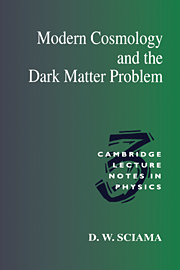Book contents
- Frontmatter
- Contents
- Preface
- Recent Developments
- Part One Dark Matter in Astronomy and Cosmology
- Part Two Ionisation Problems in Astronomy and Cosmology
- 5 Diffuse Ionisation in the Milky Way
- 6 Diffuse Ionisation in Spiral Galaxies
- 7 The Intergalactic Flux of Hydrogen-Ionising Photons
- Part Three Neutrino Decay and Ionisation in the Universe
- Part Four Observational Searches for the Neutrino Decay Line
- References
- Subject index
7 - The Intergalactic Flux of Hydrogen-Ionising Photons
Published online by Cambridge University Press: 11 January 2010
- Frontmatter
- Contents
- Preface
- Recent Developments
- Part One Dark Matter in Astronomy and Cosmology
- Part Two Ionisation Problems in Astronomy and Cosmology
- 5 Diffuse Ionisation in the Milky Way
- 6 Diffuse Ionisation in Spiral Galaxies
- 7 The Intergalactic Flux of Hydrogen-Ionising Photons
- Part Three Neutrino Decay and Ionisation in the Universe
- Part Four Observational Searches for the Neutrino Decay Line
- References
- Subject index
Summary
Introduction
The intergalactic flux of hydrogen-ionising photons plays a crucial role in the neutrino decay theory described in part 3 of this book. Accordingly in the present chapter we shall consider various observational estimates of this flux, evaluated at different cosmic epochs. While these estimates are rather uncertain, we shall find that they generally exceed the most recent determinations of the integrated contribution from quasars, which is usually regarded as the main source of the intergalactic ionising flux. Various other photon sources at high red shifts have been proposed to fill the gap, and these are discussed at the end of the chapter. In chapter 11 we shall find that the neutrino decay theory can account for the unexplained flux, but only if various parameters both of the theory and of the universe possess highly constrained values. These values are in general agreement with other estimates of them, and in some cases this agreement is rather precise.
The Density of Intergalactic Neutral Hydrogen
As soon as quasars of red shift ∼ 2 were identified by Schmidt (1965), various authors pointed out that they could be used to probe the density of intergalactic neutral hydrogen. This density could then be used in turn to constrain the intergalactic flux of ionising photons. Consider a layer of neutral hydrogen lying at a red shift z along the line of sight to a quasar of greater red shift Z. Photons emitted by the quasar and reaching the layer with the wavelength of Lyman α would be able to excite neutral hydrogen in the layer to its first excited state.
- Type
- Chapter
- Information
- Modern Cosmology and the Dark Matter Problem , pp. 100 - 116Publisher: Cambridge University PressPrint publication year: 1994



